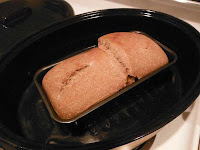 |
| The Rye Bread |
A Flop
The use of eggs in the last raisin bread made me curious: what if I added a couple of eggs to one of my regular whole grain loaves, in place of the usual hydration?
Here is one of my experiments. This dough uses the following ingredients:
- 400g ww sourdough starter @100% hydration
- 2 eggs
- 650g water
- 800g ww
- 20g salt
This dough was mixed in the evening, and turned a couple of times before bed, after adding the salt. The dough was silkier, because of the eggs. Or perhaps the hydration was off. Did the eggs make it too wet?
In the morning, it was taken from the fridge and left on the countertop for about 30 minutes, then it was shaped, divided, shaped again, and placed side-by-side in a large greased bread pan. At this point it was covered and placed in the fridge again for about 14 hours, when it was baked.
I baked it at too low a temperature (425 degrees F. x 20 minutes with the lid on, 20 minutes with the lid off). It did not bake through, something which became immediately apparent when I removed the loaf from the pan and it broke in half. The last 2 inches of the loaf were baked, and the bread tasted ok, but I had to toss away the entire middle section, it was just goo.
First Countertop Rye Bread
My first bread using the new countertop (20% Rye, the rest is ww). The day the countertop was put in, I mixed the dough in a bowl, and turned it a few times after an overnight bulk fermentation. It was divided and shaped on the new countertop.
 |
| Counter was in, but the sink wasn't plumbed yet |
We have purchased a manufactured quartz countertop, called Cambria. It looks a bit like granite, but we were sold on the strength, wearability, less porous nature, and its claims of being food-safe.
It also looks great.
When shaping the dough on it, I noticed there was less drag on the dough than with the old countertop. It's slipperier. This makes a difference when you are dragging the dough gently across a surface, trying to get the countertop to provide some drag so that the boule becomes tighter without being compressed. I'll have to practice with it some more.
First Loaves in the New Oven
Finally the new sink is in, and the new stove has arrived. This is a convection oven, and I immediately had to try it out. First impressions: it does bake much more evenly. But it has a strange feature that takes some getting used-to: when you set the oven to 500 degrees F, it automatically adjusts the temperature to a stated 475 degrees F. And when you set it to 450 degrees, it adjusts to 425 degrees F. For the first few loaves, I assumed that this is because the oven was malfunctioning, and it wasn't getting quite as hot. I thought I'd have to adjust some of the times or temperatures of the oven. But the more I look into it, the more I realize that this is one of the oven features, and it isn't a mistake.
My first two loaves, baked in a dutch oven, were preheated at 500 degrees F (which read 475 degrees F) for 30 minutes, then baked for 40 minutes at that temperature of 475 degrees F. Normally a Tartine style loaf will bake at 450 degrees for 40 minutes (which would have read 425 degrees F). I forgot to turn the temperature down to that level, and these loaves turned out fine. They were my usual 20% Rye, 80% WW sourdough loaves.
Close on the heels of these loaves, I had a Sourdough bread consisting of 40% Whole Spelt, 40% WW, and 20% rye. This loaf I baked at 450 degrees F for the first 30 minutes, and 425 degrees F for the last 10 minutes. This bread was almost baked, but not quite. Because of the lower temperature, it wasn't baked through. It was a bit gummy in a couple of places -- but that might also be because I cut into it while it was still warm. When the steam escapes due to an early knife, the crumb does not properly set. This bread was simply not as nice, because the dough wasn't baked all the way through.
I'll have to practice more with this new oven to get the hang of it.
Notes to Myself
- This convection oven seems very forgiving with its temperature. I'm really liking the stovetop induction, too.
- I'm curious to use my oven stone next: this oven cleans itself using steam, which is made when water is poured directly onto the oven floor. That feature made my eyebrows go up when we bought it. No more trays of water on the bottom rack!?
- Been a while since I made a flop loaf. Bread can keep me humble.
- Cleanup of the new stone top takes a bit of elbowgrease. One needs to use water to get the sticky dough up, and then of course the water needs to be dried with another cloth. A bit more effort is required. We are told that if you put some cold ice on the counter, it will cool down substantially, making it easier to fold pie dough. That's not my interest, but I might try it with bread dough too, just to see how it handles.

























No comments:
Post a Comment